A Review of Global Efforts in BIM Adoption for Road Infrastructure
Abstract
:1. Introduction
2. BIM for Transport Infrastructure
3. Materials and Methods
- NBPs are documents (i.e., not websites, blogs, or similar formats);
- NBPs reflect BIM knowledge (i.e., publications focused on skills, BIM tools, government adoption decrees, or roadmaps are excluded);
- NBPs are the results of BIM participants (i.e., publications delivered by participants from other industries are excluded);
- NBPs cover relevant BIM topics (i.e., publications covering pre-BIM maturity stage topics are excluded); and
- NBPs are macroscopic (i.e., documents intended for small groups of professionals or students are excluded).
- NBPs originate from collaboration within the AECO sector (i.e., they are not individual contributions); and
- NBPs are not translations of other NBPs.
- Verify the global effort on road infrastructure;
- Identify the period of growth in the number of publications;
- Verify the countries with the largest collections of NBPs and track their evolution over the years;
- Assess the alignment of these collections with the relevance of scientific article publications;
- Evaluate the BIM maturity of the publications, as presented by Succar [1], reflecting the capability of the BIM methodology and setting critical milestones for its evolution; and
- Investigate the adherence of the publications to ISO 19650 [30], an international standard specifying requirements for information management using BIM throughout the asset lifecycle. This standard, based on the PAS 1192 series [31,32,33,34], covers concepts, principles, asset delivery and operation phases, and digital security, aiming for process standardization, increased efficiency and collaboration, ensuring information quality, risk reduction, and an integrated project lifecycle approach.
4. Results
4.1. The Growth of Publications
4.2. Adoption Effort
4.2.1. Australia
4.2.2. Brazil
4.2.3. Croatia
4.2.4. Denmark
4.2.5. United Arab Emirates
4.2.6. Finland
4.2.7. Norway
4.2.8. United Kingdom
4.2.9. United States of America
4.2.10. Joint Initiatives
5. Discussion
5.1. Global Effort on Road Infrastructure
5.2. Comparison between Academic Production and NBP
5.3. The Delay Compared to the Buildings Sector
- IFC 4.2-2016: This update to IFC 4 focused on bug fixes and minor improvements, reinforcing IFC’s capability to support infrastructure projects [73]; and
- IFC 4.3-2022: The latest update resulted from a multi-year international process and introduced IFCRail and IFCInfra. Alongside corrections and minor improvements, this version enhanced IFC’s capacity to accommodate bridges, ports, waterways, and elongated elements such as roads and railways [53].
5.4. BIM Maturity Stage of Publications
- Stage 1—Modeling focus: marks the beginning of the transition from traditional CAD to BIM;
- Stage 2—Collaboration focus: project team members begin to actively collaborate through multidisciplinary models; and
- Stage 3—Integration focus: characterized by the creation, sharing, and collaborative maintenance of rich data integrated or federated models, with all necessary information and data for project development extracted from a single model in a common data environment (CDE).
5.5. Adherence to ISO 19.650
6. Conclusions
Author Contributions
Funding
Data Availability Statement
Conflicts of Interest
Abbreviations
| AASHTO | American Association of State Highway and Transportation Officials |
| AECO | Architecture, Engineering, Construction, and Operations |
| BEIS | Department for Business, Energy and Industrial Strategy of United Kingdom |
| BIM | building information modeling |
| BSI | British Standards Institute |
| CDBB | Centre for Digital Built Britain |
| DER-PR | Department of Roads and Highways-Paraná |
| DFT | Department for Transport of United Kingdom |
| DNIT | National Department of Transport Infrastructure OF Brazil |
| DRD | Danish Road Directorate |
| DOAJ | Directory of open-access journals |
| FTIA | Väylävirasto or Finnish Transport Infrastructure Agency |
| FHWA | Federal Highway Administration |
| GIS | Geographic Information System |
| MDPI | Multidisciplinary Digital Publishing Institute |
| NBP | Noteworthy BIM Publications |
| RWS | Rijkswaterstaat or General Directorate of the Ministry of Infrastructure and Water Management of the Netherlands |
| UNECE | United Nations Economic Commission for Europe |
References
- Succar, B. Building Information Modelling Maturity Matrix. In Handbook of Research on Building Information Modelling and Construction Informatics: Concepts and Technologies; IGI Publishing: Hershey, PA, USA, 2010; pp. 65–103. [Google Scholar] [CrossRef]
- Jung, Y.; Joo, M. Building information modelling (BIM) framework for practical implementation. Autom. Constr. 2011, 20, 126–133. [Google Scholar] [CrossRef]
- Corrêa, S.L.M.; Siviero, L.F.; Freitas, R.D.O.; Corrêa, F.R.; Santos, E.T. BIM para infraestrutura de transportes. In Simpósio Brasileiro de Tecnologia da Informação e Comunicação na Construção; ANTAC: Porto Alegre, Brazil, 2019; pp. 1–8. [Google Scholar] [CrossRef]
- Han, C.; Tang, F.; Ma, T.; Gu, L.; Tong, Z. Construction quality evaluation of asphalt pavement based on BIM and GIS. Autom. Constr. 2022, 141, 104398. [Google Scholar] [CrossRef]
- Bongiorno, N.; Bosurgi, G.; Carbone, F.; Pellegrino, O.; Sollazzo, G. Potentialities of a Highway Alignment Optimization Method in an I-BIM Environment. Period. Polytech. Civ. Eng. 2019, 63, 352–361. [Google Scholar] [CrossRef]
- Cepa, J.J.; Pavôn, R.M.; Alberti, M.G.; Ciccone, A.; Asprone, D. A Review on the Implementation of the BIM Methodology in the Operation Maintenance and Transport Infrastructure. Appl. Sci. 2023, 13, 3176. [Google Scholar] [CrossRef]
- Omoregie, A.; Turnbull, D.E. Highway infrastructure and Building Information Modelling in UK. Proc. Inst. Civ. Eng.-Munic. Eng. 2016, 169, 220–232. [Google Scholar] [CrossRef]
- Tang, F.; Ma, T.; Zhang, J.; Guan, Y.; Chen, L. Integrating three-dimensional road design and pavement structure analysis based on BIM. Autom. Constr. 2020, 113, 103152. [Google Scholar] [CrossRef]
- Jones, S.; Laquidara-Carr, D.; Lorenz, A.; Buckley, B.; Barnett, S. The business value of BIM for infrastructure 2017. SmartMarket Report; Dodge Data & Analytics: Bedford, UK, 2017. [Google Scholar]
- Vitásek, S.; Zak, J. Cost estimating and building information modelling (BIM) in road construction. In Proceedings of the Creative Construction Conference 2018-Proceedings, Budapest University of Technology and Economics, Ljubljana, Slovenia, 30 June–3 July 2018; pp. 403–410. [Google Scholar] [CrossRef]
- Cepa, J.J.; Pavôn, R.M.; Alberti, M.G.; Caramés, P. Towards BIM-GIS integration for road intelligent management system. J. Civ. Eng. Manag. 2023, 29, 621–638. [Google Scholar] [CrossRef]
- Zhang, J.; Zhao, C.; Li, H.; Huijser, H.; Skitmore, M. Exploring an Interdisciplinary BIM-Based Joint Capstone Course in Highway Engineering. J. Civ. Eng. Educ. 2020, 146, 05020004. [Google Scholar] [CrossRef]
- Chong, H.Y.; Lopez, R.; Wan, J.; Wang, X.; Zhao, Z. Comparative Analysis on the Adoption and Use of BIM in Road Infrastructure Projects. J. Manag. Eng. 2016, 32, 05016021. [Google Scholar] [CrossRef]
- Ghasemzadeh, B.; Celik, T.; Karimi Ghaleh Jough, F.; Matthews, J.C. Road Map to BIM Use for Infrastructure Domains: Identifying and Contextualizing Variables of Infrastructure Projects. Sci. Iran. 2022, 29, 2803–2824. [Google Scholar] [CrossRef]
- Ait-Lamallam, S.; Yaagoubi, R.; Sebari, I.; Doukari, O. Extending the IFC Standard to Enable Road Operation and Maintenance Management through OpenBIM. ISPRS Int. J. Geo-Inf. 2021, 10, 496. [Google Scholar] [CrossRef]
- Silva, S.P.; Viana, F.; Cerqueira, A.; Souza, B. A tecnologia BIM como ferramenta de maximização de resultados. Rev. Interdiscip. Pensamento Científico 2019, 5. Available online: http://reinpec.cc/index.php/reinpec/article/view/307 (accessed on 10 July 2024).
- Zheng, L.; Lu, W.; Chen, K.; Chau, K.W.; Niu, Y. Benefit sharing for BIM implementation: Tackling the moral hazard dilemma in inter-firm cooperation. Int. J. Proj. Manag. 2017, 35, 393–405. [Google Scholar] [CrossRef]
- Ojo, S.A.; Olusina, J.O.; Ngene, B.U.; Busari, A.A.; Adediran, J.; Eletu, A. Assessment of road infrastructure using remote sensing and GIS methodology for monitoring the condition of paved and unpaved roads. IOP Conf. Ser. Mater. Sci. Eng. 2019, 640, 012099. [Google Scholar] [CrossRef]
- Bradley, A.; Li, H.; Lark, R.; Dunn, S. BIM for infrastructure: An overall review and constructor perspective. Autom. Constr. 2016, 71, 139–152. [Google Scholar] [CrossRef]
- Costin, A.; Adibfar, A.; Hu, H.; Chen, S.S. Building Information Modeling (BIM) for transportation infrastructure—Literature review, applications, challenges, and recommendations. Autom. Constr. 2018, 94, 257–281. [Google Scholar] [CrossRef]
- Agdas, D.; Ellis, R.D. IT in transportation construction: Opportunities and barriers to implementation. In Proceedings of the International Conference on Computing in Civil and Building Engineering, Nottingham, UK, 30 June–2 July 2010. [Google Scholar]
- Eastman, C.M. (Ed.) BIM Handbook: A Guide to Building Information Modeling for Owners, Managers, Designers, Engineers and Contractors, 2nd ed.; Wiley: Hoboken, NJ, USA, 2011. [Google Scholar]
- Nunes, D.R.D.C.; Felicetti, L.; Witiuk, R.; Gomes, S.; Miceli Junior, G.; Pellanda, P.C. Análise do nível de desenvolvimento requerido para modelagem em BIM de projetos de infraestrutura de transportes. In Proceedings of the 35° ANPET, virtual, 8–18 November 2021. [Google Scholar]
- Nielsen, O.A.; Miceli Junior, G.; Pellanda, P.C. Estudo da expansão de pesquisas em BIM a partir de palavras-chave: Uma análise bibliométrica. In Simpósio Brasileiro de Tecnologia da Informação e Comunicação na Construção; ANTAC: Porto Alegre, Brazil, 2023; Volume 4. [Google Scholar] [CrossRef]
- Okoli, C. A Guide to Conducting a Standalone Systematic Literature Review. Commun. Assoc. Inf. Syst. 2015, 37, 885. [Google Scholar] [CrossRef]
- De Melo Simões, C.R.S.; dos Santos, G.J.R.; de Almeida-Filho, A.T.; Palha, R.P. BIM para infraestruturas rodoviárias: Uma revisão sistemática. In ImpóSio Brasileiro de Tecnologia da Informação e Comunicação na Construção; ANTAC: Porto Alegre, Brazil, 2023; Volume 4, pp. 1–9. [Google Scholar] [CrossRef]
- Strieder, H.L.; Schreinert, G.G. Metodologia BIM em obras de infraestrutura: Uma revisão sistemática. In Proceedings of the 47th Reunião Anual de Pavimentação (RAPv), Bento Gonçalves, Brazil, 9–12 August 2022. [Google Scholar]
- Kassem, M.; Succar, B.; Dawood, N. Building Information Modeling: Analyzing Noteworthy Publications of Eight Countries Using a Knowledge Content Taxonomy. In American Society of Civil Engineers; Teesside University: Middlesbrough, UK, 2015; pp. 329–371. [Google Scholar] [CrossRef]
- Borges, M.; Melo, R.; Giesta, J.; Santos, D. Characterization of the use of BIM in the Brazilian states Rio Grande do Norte e Paraiba. In Proceedings of the 37th CIB W78 Information Technology for Construction Conference (CIB W78), São Paulo, Brazil, 2–4 June 2020; pp. 204–217. [Google Scholar] [CrossRef]
- ISO 19650-1; 2018 Organization and Digitization of Information about Buildings and Civil Engineering Works, Including Building Information Modelling (BIM)—Information Management Using Building Information Modelling—Part 1: Concepts and Principles. International Organization for Standardization: Geneva, Switzerland, 2018.
- BSI 1192:2007; Collaborative Production of Architectural, Engineering and Construction Information-Code of Practice. British Standards Institution: London, UK, 2007.
- PAS 1192-3:2014; Specification for Information Management for the Operational Phase of Assets Using Building Information Modelling. British Standards Institution: London, UK, 2014.
- PAS 1192-2:2015; Specification for information management for the capitaldelivery phase of construction projects using building information modelling. British Standards Institution: London, UK, 2015.
- PAS 1192-5:2015; Specification for Security-Minded Building Information Modelling, Digital Built Environments and Smart Asset Management. British Standards Institution: London, UK, 2015.
- Cheng, J.C.P.; Lu, Q.; Student, M.P. A review of the efforts and roles of the public sector for BIM adoption worldwide. J. Inf. Technol. Constr. 2015, 20, 442–478. [Google Scholar]
- National BIM Guidelines and Case Studies for Infrastructure. 2017. Available online: https://sbenrc.com.au/app/uploads/2013/10/National-BIM-Guidelines-FINAL.pdf (accessed on 10 July 2024).
- Gelder, J. Asset Data Harmonisation Stage III: BIM IFC Alignment Review; Austroads: Sydney, Australia, 2018; Available online: https://austroads.com.au/publications/asset-management/ap-t333-18 (accessed on 10 July 2024).
- Powers, N. Guide to Project Delivery Part 2: Planning and Control; Austroads: Sydney, Australia, 2018; Available online: https://austroads.com.au/publications/project-delivery/agpd02 (accessed on 10 July 2024).
- Building Information Modelling (BIM) for Transport and Main Roads. Queensland Government, Australia, 2021. Available online: https://www.tmr.qld.gov.au/business-industry/Technical-standards-publications/Building-Information-Modelling (accessed on 10 July 2024).
- Caderno de requisitos técnicos BIM do DNIT. Departamento nacional de Infraestrutura de Transporte, Brasil, 2023. Available online: https://www.gov.br/dnit/pt-br/assuntos/planejamento-e-pesquisa/bim-no-dnit/mosaico-de-servicos/documentos-tecnicos-bim/CRTBIM_V012022.pdf (accessed on 10 July 2024).
- Manual BIM para Desenvolvimento de Projetos de Urbanismo e Infraestrutura. Secretaria de Obras e Infraestrutura do Distrito Federal, Brasil, 2023. 2020. Available online: https://www.so.df.gov.br/wp-conteudo/uploads/2023/08/MANUAL_BIM_R07_03_01_23__Versao_Final-1.pdf (accessed on 10 July 2024).
- Filip, A.; Zlata, D.A.; Anton, E.; Dražen, G.; Mirko, G. Smjernice za BIM Pristup u Infrastrukturnim Projektima; Hrvatska Komora Inženjera Građevinarstva: Zagreb, Croatia, 2021. [Google Scholar]
- Olsen, P.B.; Breiner, O.M.; Pape, D.W. A Practical Guide to BIM in Construction and Infrastructure Projects; MTHojgaard: Søborg, Denmark, 2015. [Google Scholar]
- BIM Documentation Guidelines for Infrastructure; Department of Municipalities and Transport: Abu Dhabi, United Arab Emirates, 2020. Available online: https://www.dmt.gov.ae/adm/-/media/Project/DMT/ADM/E-Library/0001-Jan-2022-Doc/ADM-BIM-002Documentation-Guidelines-for-Infrastructure-projects.pdf (accessed on 10 July 2024).
- Saarnikko, J. BIM Guidelines for Bridges. Finnish Transport Infrastructure Agency, Finland, 2014. Available online: https://ava.vaylapilvi.fi/ava/Julkaisut/Liikennevirasto/lo_2014-06eng_bim_guidelines_web.pdf (accessed on 10 July 2023).
- Oy, S.S.D. Common InfraBIM Requirements-YIV2015; buildingSMART: Helsinki, Finland, 2015; Available online: https://wiki.buildingsmart.fi/en/04_Guidelines_and_Standards/COBIM_Infra_Requirements (accessed on 6 July 2023).
- Common InfraBIM Requirements-YIV2015-Managing Model Based Project. buildingSMART: Finland, 2015. Available online: https://wiki.buildingsmart.fi/en/04_Guidelines_and_Standards/COBIM_Infra_Requirements (accessed on 9 July 2023).
- Common InfraBIM Requirements-Data Exchange Requirements for Handover Material. buildingSMART: Finland, 2019. Available online: https://wiki.buildingsmart.fi/en/04_Guidelines_and_Standards/COBIM_Infra_Requirements (accessed on 10 July 2023).
- Common InfraBIM Requirements-YIV 2019-General Inicial Data Design Construction. buildingSMART: Finland, 2019. Available online: https://wiki.buildingsmart.fi/en/04_Guidelines_and_Standards/COBIM_Infra_Requirements(accessed on 10 July 2023).
- Sinikka, K. Väyläviraston ohjeita 32/2022. Finnish Transport Infrastructure Agency, Finland, 2022. Available online: https://ava.vaylapilvi.fi/ava/Julkaisut/Vaylavirasto/vo_2022-32_inframallivaatimukset.pdf (accessed on 10 July 2023).
- Manual R110. Statens Vegvesen, Norway, 2023. Available online: https://store.vegnorm.vegvesen.no/r110 (accessed on 10 July 2023).
- Håndbok for Digital Planlegging-Veiledning; Bane NOR: Oslo, Norway, 2022.
- Status of LOD and Related Work at Nordic Infrastructure Clients; Nordic Road & Rail BIM Colanoration: Norway, 2022; Available online: https://www.bimalliance.se/media/dgulrzt3/nbc-report-status-of-lod-and-related-work-at-nordic-infrastructure-clients.pdf (accessed on 10 July 2023).
- Building Information Modeling (BIM) Practices in Highway Infrastructure; US Department of Transportation: Atlanta, GA, USA, 2021.
- BS 1192-4:2014; Collaborative Production of Information—Part 4: Fulfilling Employer’s Information Exchange Requirements Using COBie—Code of Practice. British Standards Institution: London, UK, 2014.
- ISO 19650-2: 2018; Organization and Digitization of Information about Buildings and Civil Engineering Works, Including Building Information Modelling (BIM)—Information Management Using Building Information Modelling—Part 2: Delivery Phase of the Assets. International Organization for Standardization: Geneva, Switzerland, 2018.
- ISO 19650-3: 2020; Organization and Digitization of Information about Buildings and Civil Engineering Works, Including Building Information Modelling (BIM)—Information Management Using Building Information Modelling—Part 3: Operational Phase of the Assets. International Organization for Standardization: Geneva, Switzerland, 2020.
- ISO 19650-4: 2022; Organization and Digitization of Information about Buildings and Civil Engineering Works, Including Building Information Modelling (BIM)—Information Management Using Building Information Modelling—Part 4: Information Exchange. International Organization for Standardization: Geneva, Switzerland, 2022.
- ISO 19650-5: 2020; Organization and Digitization of Information about Buildings and Civil Engineering Works, Including Building Information Modelling (BIM)—Information Management Using Building Information Modelling—Part 5: Security-Minded Approach to Information Management. International Organization for Standardization: Geneva, Switzerland, 2020.
- Maier, F.; Chummers, L.E.; Pulikanti, S.; Struthers, J.Q.; Mallela, J.; Morgan, R.H. Utilizing 3D Digital Design Data in Highway Construction-Case Studies; Federal Highway Administration: Washington, DC, USA, 2017. [Google Scholar]
- Maier, F. Automation in Highway Construction Part II: Design Guidance and Guide Specification Manual; Federal Highway Administration: Washington, DC, USA, 2018. [Google Scholar]
- Effective Use of Geospatial Tools in Highway Construction; U.S. Federal Highway Administration: Washington, DC, USA, 2019.
- Wood, N.C. Advancing the Development and Deployment of BIM Background for Infrastructure; Federal Highway Administration: Washington, DC, USA, 2020. [Google Scholar]
- Wood, N.C. The Dimensions of BIM for Infrastructure; Federal Highway Administration: Washington, DC, USA, 2020. [Google Scholar]
- Biancardo, S.A.; Viscione, N.; Cerbone, A.; Dessì, E. BIM-Based Design for Road Infrastructure: A Critical Focus on Modeling Guardrails and Retaining Walls. Infrastructures 2020, 5, 59. [Google Scholar] [CrossRef]
- Mitchell, A.; Williges, C.; Messner, J. Cooperative Research Program Division; Transportation Research Board; National Academies of Sciences, Engineering, and Medicine. In Lifecycle Building Information Modeling for Infrastructure: A Business Case for Project Delivery and Asset Management; Transportation Research Board: Washington, DC, USA, 2022. [Google Scholar] [CrossRef]
- Šimenić, D. Building Information Modelling (BIM) for Road Infrastructure: TEM Requirements and Recommendations; United Nations Economic Commission for Europe: Geneva, Switzerland, 2021. [Google Scholar]
- Salzano, A.; Intignano, M.; Mottola, C.; Biancardo, S.A.; Nicolella, M.; Dell’Acqua, G. Systematic Literature Review of Open Infrastructure BIM. Buildings 2023, 13, 1593. [Google Scholar] [CrossRef]
- Vignali, V.; Acerra, E.M.; Lantieri, C.; Di Vincenzo, F.; Piacentini, G.; Pancaldi, S. Building information Modelling (BIM) application for an existing road infrastructure. Autom. Constr. 2021, 128, 103752. [Google Scholar] [CrossRef]
- Eastman, C.; Teicholz, P.; Sacks, R.; Liston, k. BIM Handbook: A Guide to Building Information Modeling; Wiley: Hoboken, NJ, USA, 2008. [Google Scholar]
- ISO 12006-3:2007; Building Construction-Organization of Information about Construction Works—Part 3: Framework for Object-Oriented Information. International Organization for Standardization: Geneva, Switzerland, 2007.
- ISO 16739:2013; Industry Foundation Classes (IFC) for Data Sharing in the Construction and Facility Management Industries. International Organization for Standardization: Geneva, Switzerland, 2013.
- Ribeiro, S.A.; Krauss, P.F. Análise comparativa entre versões de arquivos IFC utilizando a verificação de interferência. In Proceedings of the SBTIC, Campinas, Brazil; 2019; pp. 1–5. [Google Scholar] [CrossRef]
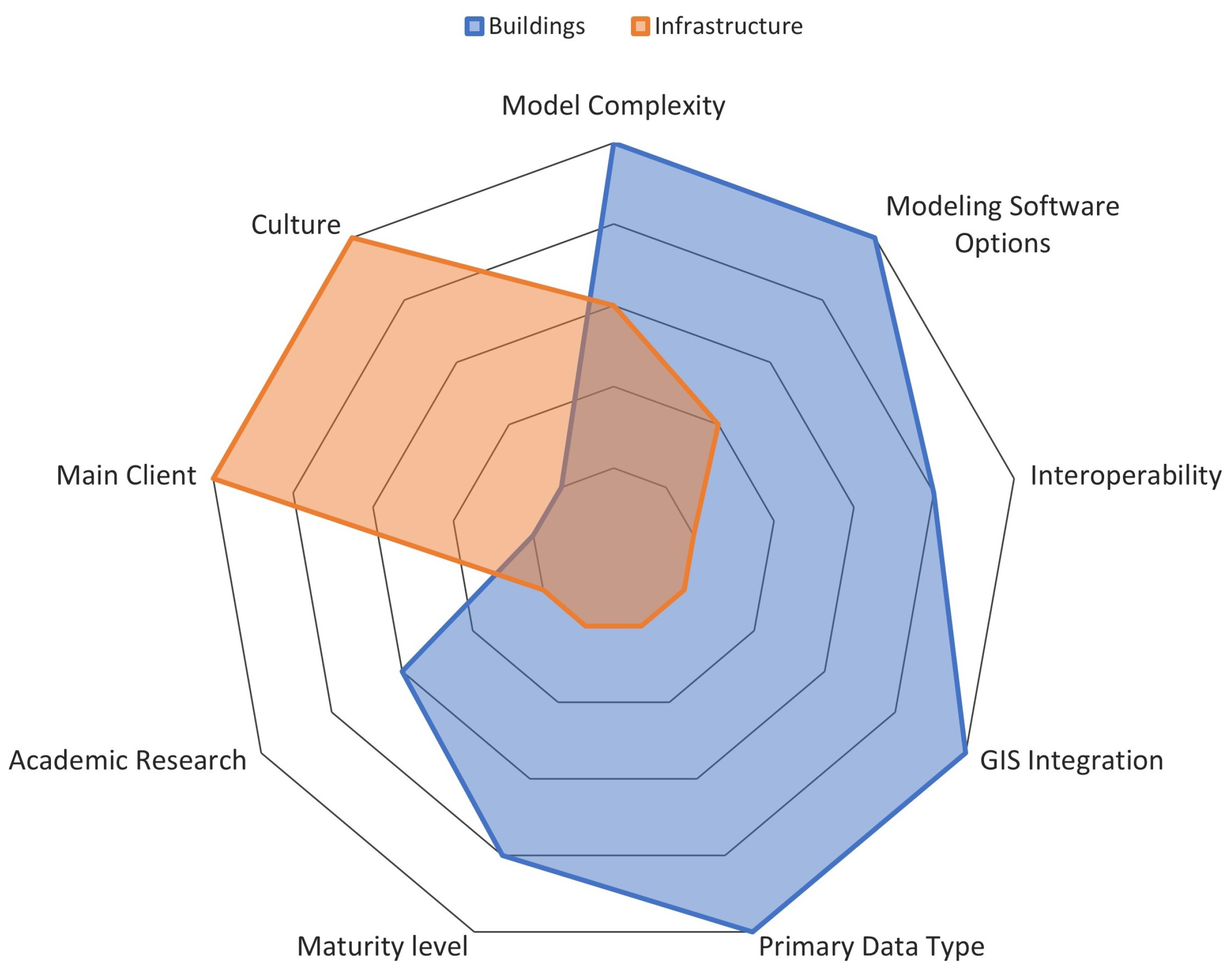

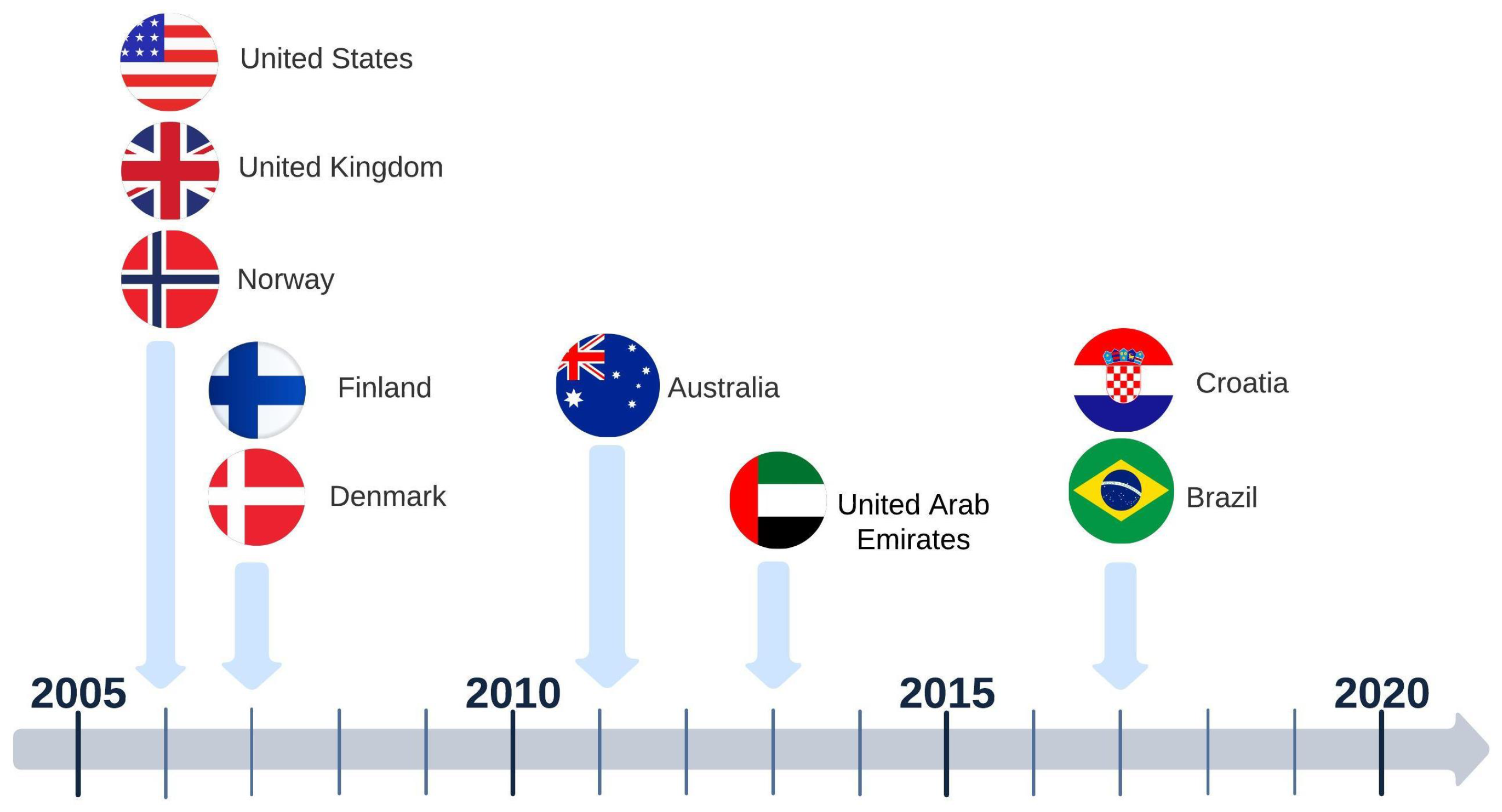
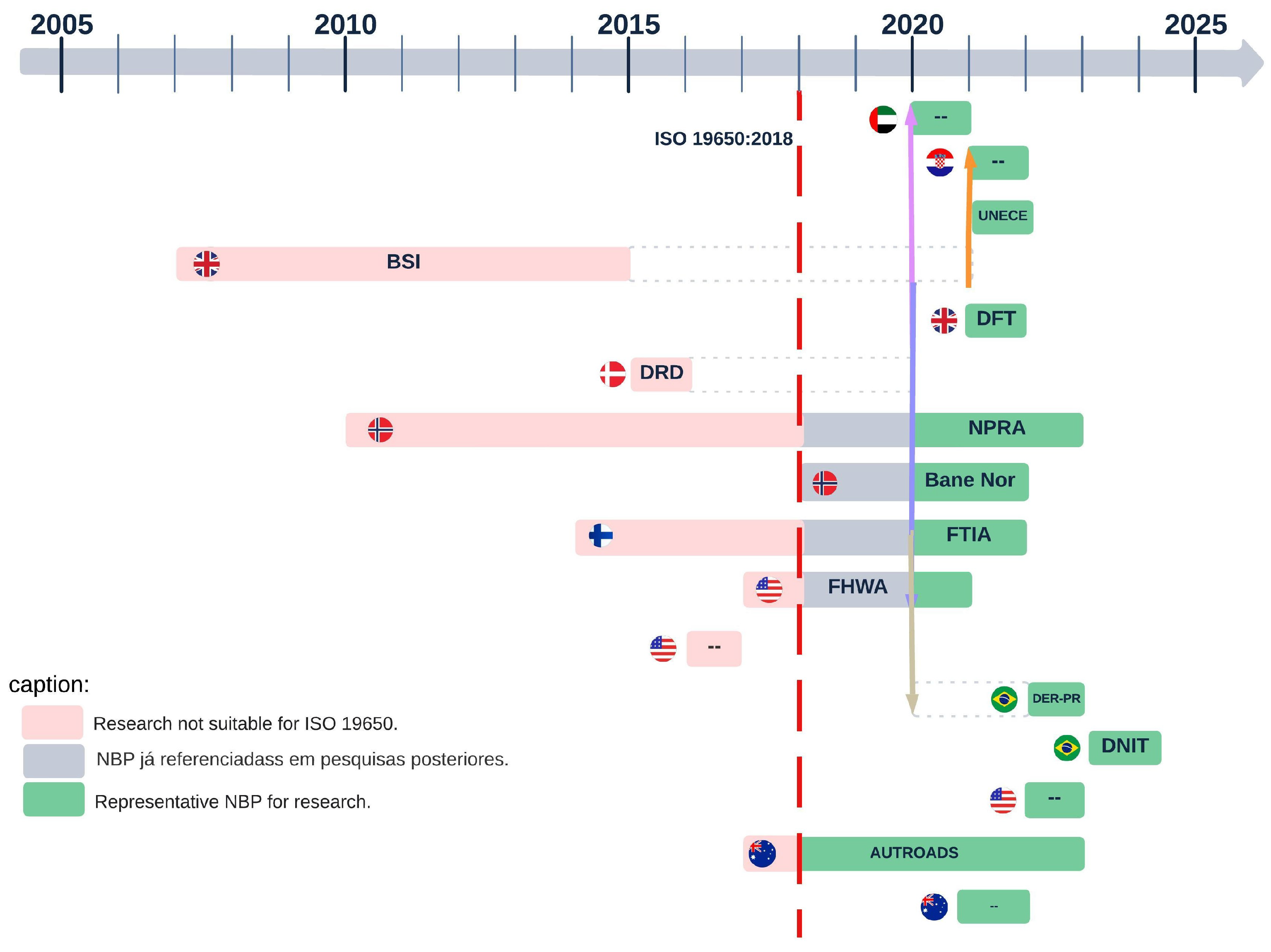
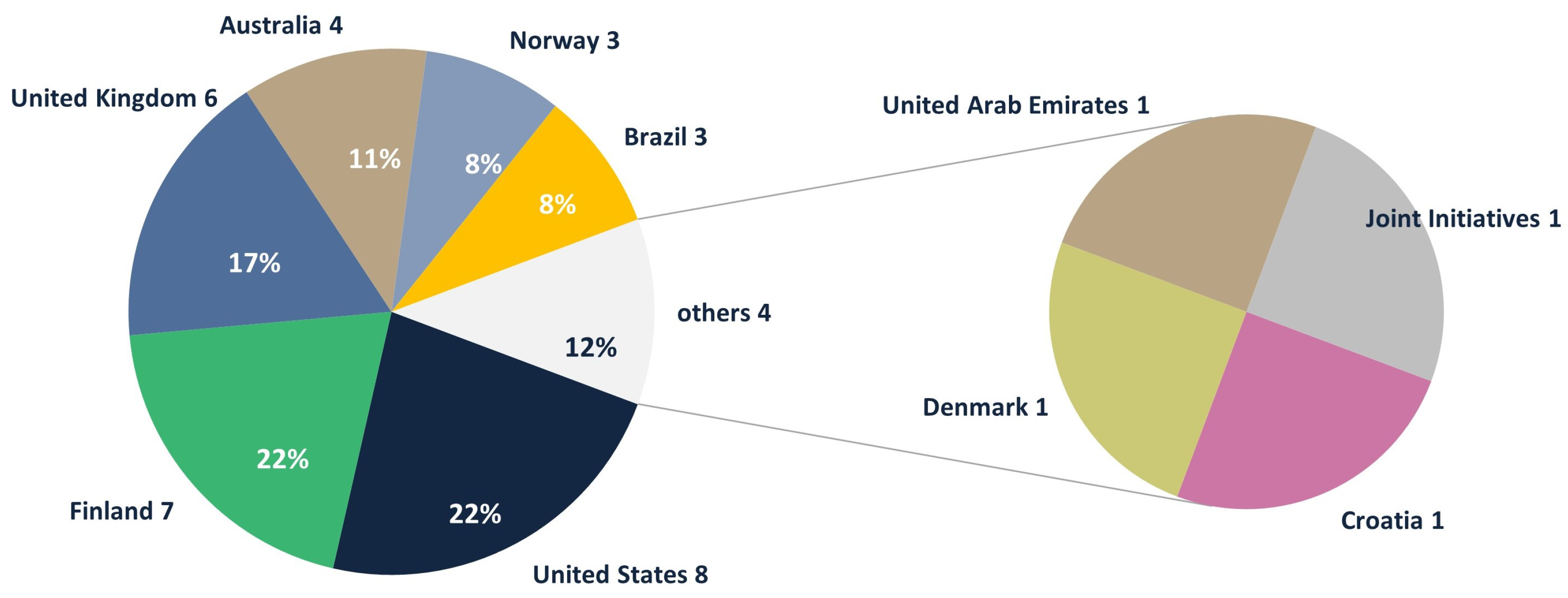
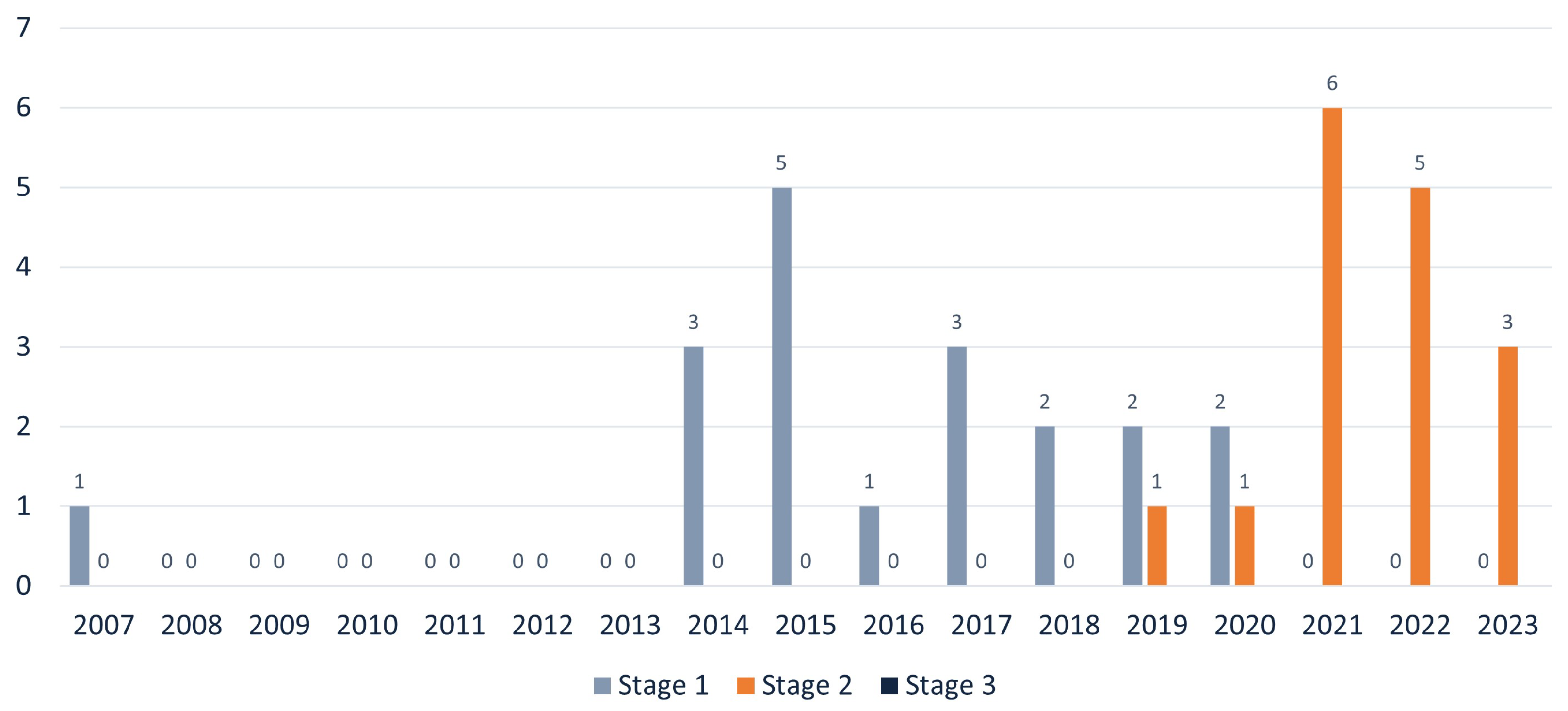

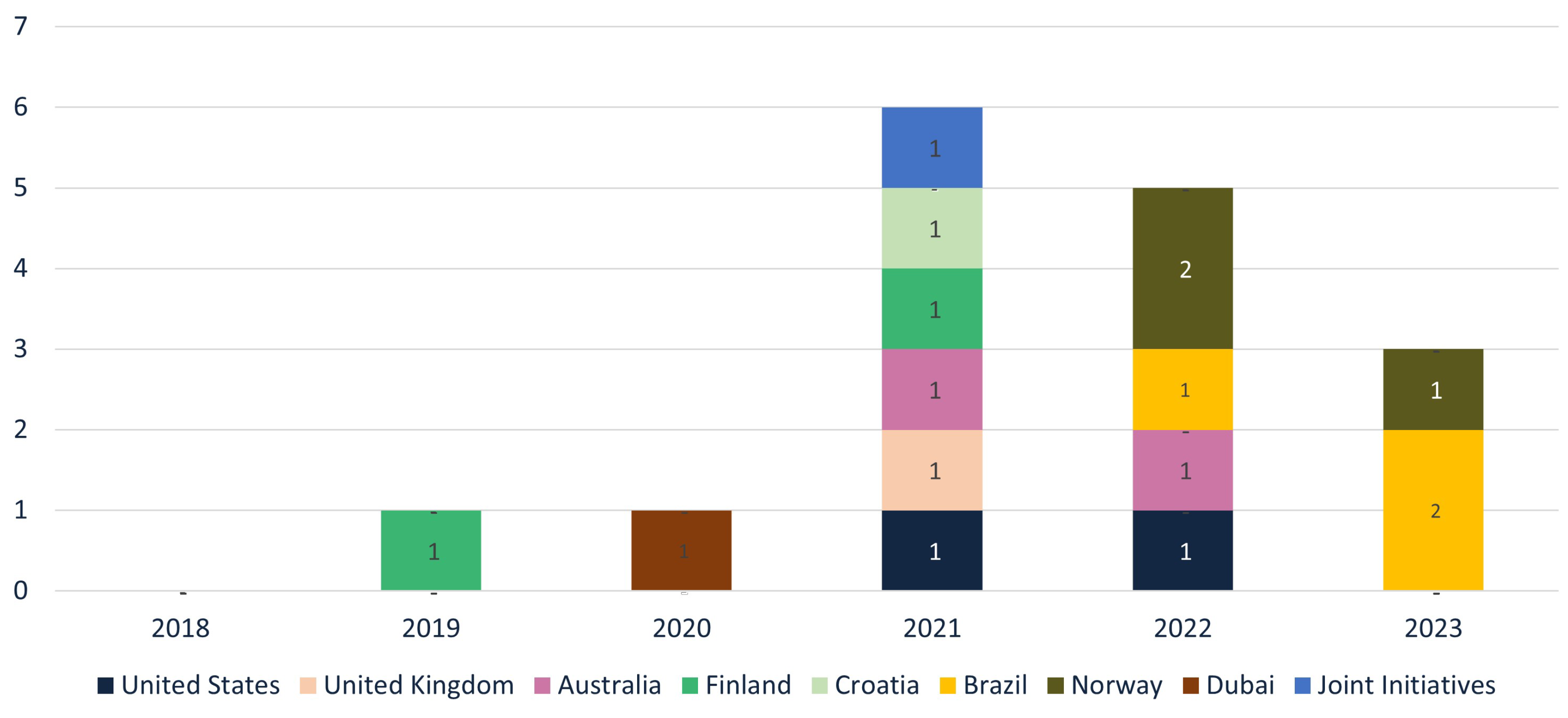
| Main Differences | Infrastructure | Buildings | Author |
|---|---|---|---|
| Model Complexity | Lower | Higher | [3] |
| Modeling Software Options | Fewer | More | [3] |
| Interoperability | Lower | Reasonable | [3] |
| Maturity level | Lower | Higher | [19,23] |
| Academic Research | Limited | Reasonable | [19,24] |
| Main Client | Public | Private | [3,21] |
| Culture | Constructor | Designer | [3] |
| GIS Integration | Dependent | Independent | [6] |
| Primary Data Type | Non-graphical | Graphical | [19] |
| Country | Qtd | % |
|---|---|---|
| Australia | 4 | 11.4% |
| Brazil | 3 | 8.5% |
| Croatia | 1 | 2.8% |
| Denmark | 1 | 2.8% |
| United Arab Emirates | 1 | 2.8% |
| Finland | 7 | 20% |
| Norway | 3 | 8.5% |
| United States | 8 | 22.8% |
| United Kingdom | 6 | 17.1% |
| Joint Initiatives | 1 | 2.8% |
| Total | 35 (9 Countries) | |
| Country | Abbreviations | Agencies |
|---|---|---|
| Australia | Autoroads | Association of Australian and New Zealand road transport |
| Brazil | DER-PR | Department of Roads and Highways-Paraná |
| DNIT | National Department of Transport Infrastructure of Brazil | |
| Denmark | DRD | Danish Road Directorate |
| Finland | FTIA | Finnish Transport Infrastructure Agency |
| Norway | NPRA | Norwegian Public Roads Administration |
| bane Nor | Norwegian government agency of Railway | |
| United States | AASHTO | American Association of State Highway and Transportation Officials |
| FHWA | Federal Highway Administration | |
| United Kingdom | BEIS | Department for Business, Energy and Industrial Strategy of United Kingdom |
| United Kingdom | CDBB | Centre for Digital Built Britain |
| DFT | Department for Transport of United Kingdom | |
| BSI | British Standards Institute | |
| Joint Initiatives | UNECE | United Nations Economic Commission for Europe |
Disclaimer/Publisher’s Note: The statements, opinions and data contained in all publications are solely those of the individual author(s) and contributor(s) and not of MDPI and/or the editor(s). MDPI and/or the editor(s) disclaim responsibility for any injury to people or property resulting from any ideas, methods, instructions or products referred to in the content. |
© 2024 by the authors. Licensee MDPI, Basel, Switzerland. This article is an open access article distributed under the terms and conditions of the Creative Commons Attribution (CC BY) license (https://creativecommons.org/licenses/by/4.0/).
Share and Cite
Nielsen, O.A.; Miceli, G., Jr.; Ferreira Filho, A.d.S.; Pellanda, P.C. A Review of Global Efforts in BIM Adoption for Road Infrastructure. Infrastructures 2024, 9, 126. https://doi.org/10.3390/infrastructures9080126
Nielsen OA, Miceli G Jr., Ferreira Filho AdS, Pellanda PC. A Review of Global Efforts in BIM Adoption for Road Infrastructure. Infrastructures. 2024; 9(8):126. https://doi.org/10.3390/infrastructures9080126
Chicago/Turabian StyleNielsen, Otto Araujo, Giuseppe Miceli, Jr., Altair dos Santos Ferreira Filho, and Paulo César Pellanda. 2024. "A Review of Global Efforts in BIM Adoption for Road Infrastructure" Infrastructures 9, no. 8: 126. https://doi.org/10.3390/infrastructures9080126








